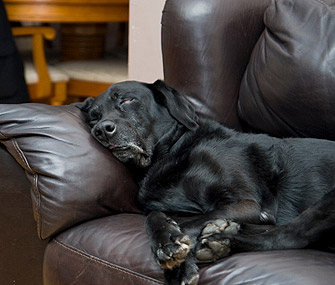Canine Hypothyroidism: How to Spot and Treat This Subtle Disease
Published on July 20, 2015
Skip To

Hypothyroidism occurs when the thyroid glands do not produce enough thyroid hormones. If a dog is hypothyroid, there is a very slim possibility that a tumor is present. However, in most cases, it is simply a dysfunctional thyroid gland.
Symptoms of Canine Hypothyroidism
As with feline hyperthyroidism, the signs of canine hypothyroidism vary widely, but the most common are weight gain, hair loss or poor haircoat, rough or scaly skin and lethargy. Breeds particularly at risk for this disease include Doberman Pinschers, Labrador Retrievers, Golden Retrievers and Great Danes.Contact your veterinarian if your pet is exhibiting any of the following signs:
- His affection for chasing balls slows down, and he lags behind on walks.
- His hair is falling out, or his haircoat is dull and brittle.
- He sleeps more than usual.
- His skin seems dry and scaly and may have darkened in color.
- He seems to be putting on weight.
- He prefers warm spots and gets cold easily.
The thyroid glands are located on each side of the dog’s trachea. If only one thyroid gland becomes cancerous, the dog may have normal thyroid production and only exhibit a mass in the neck. If left unchecked, the lump can grow quite large and can invade the neck muscles, larynx, esophagus or even the lungs. Signs may include a cough or problems swallowing. Fortunately, only one gland is usually compromised by the tumor, and some thyroid tumors can be removed.
Testing and Management
Canine hypothyroidism can be a subtle disease. Signs appear gradually and dog owners may mistake their dog’s lethargy, weight gain and inactivity for signs of aging rather than hypothyroidism.
Dogs with hypothyroidism are typically middle aged. Seven years is the average age of onset, and testing dogs with clinical signs is essential.
Hypothyroidism is diagnosed by a group of blood tests that help determine levels of thyroid hormones. The most common test is a T4 test, which is a measurement of blood levels of total thyroxine, the main hormone that is secreted from the thyroid glands. Other tests that are often run concurrently include TSH (thyroid-stimulating hormone) and free T4. These two tests provide supportive information because T4 levels can vary and may be low due to illness unrelated to thyroid problems.
Treatment is lifelong supplementation with a synthetic thyroid hormone called levothyroxine; blood tests are used to determine any necessary dosage adjustments. Improvement in attitude and activity level can usually be seen within a week or two.
More on Vetstreet:





